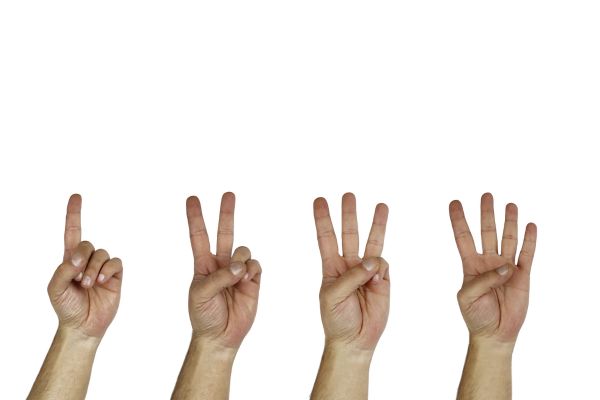Want to get rid of your old T.V. or microwave but not sure what to do with it? These items are referred to as e-cycling or, more commonly, e-waste. Below we will explain what e-waste is and show you how you can dispose of it responsibly.
Our lives are filled with conveniences delivered to us via some electronic gadget or appliance. Fridges keep our food fresh, and phones allow us to stay connected; we can cook, clean, and maintain our homes with ease thanks to many of these gadgets. We also get a lot of enjoyment from other devices like battery-operated toys for our kids, power tools, game consoles, and even our hairdryers and curlers.
All of this convenience comes at a cost, though. These gadgets don’t last forever, and we are being bombarded with shiny new devices every day. We have created this world where we need to have the latest, fasted, the smallest, biggest, or fanciest gadget available even though the device we have often still works.
Then there is built-in obsolescence. This is where companies build objects to only last a short period of time or make it difficult for the battery to be replaced so that we need to buy a new one every time. They may even change the cable, so you have to purchase new accessories all the time.
What is E-Waste
Electronic products that have reached their end of life because they are no longer working or no longer wanted are e-waste. Another term you might see used is WEEE, which stands for ‘Waste Electrical and Electronic Equipment.’
The best way to determine if an item is e-waste or WEEE is to look and see if it has a plug, cord, or battery. Phones and televisions are the most obvious examples, but e-waste includes your fridge, hairdryer, lawnmower, and kid’s toy.



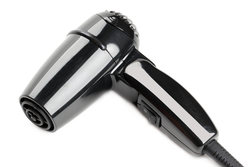
What’s the Problem With E-Waste
The problem is that most E-waste contains toxic chemicals and may also contain PVC plastic and other hazardous substances like flame retardants. Examples of poisonous metals in electronic gadgets are mercury, beryllium, cadmium, mercury, and lead. All of which can cause significant harm to the environment.
In landfills, these chemicals can leach into the groundwater, transporting
toxic substances into the surrounding environment.
E-cycling or WEEE also contains precious metals like gold, silver, copper, platinum, lithium, cobalt, palladium. These can also be recovered and reused, saving energy and the environmental impacts from mining virgin materials.
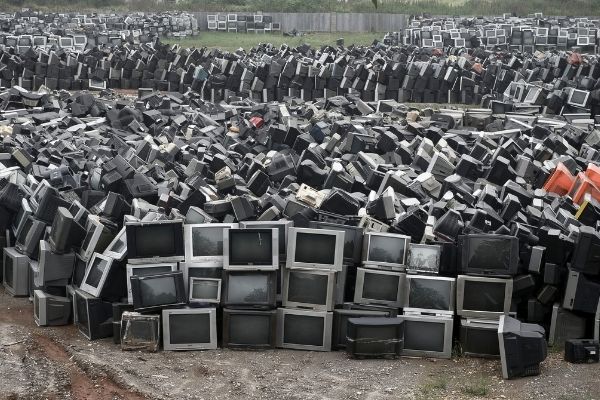
E-waste is not a new problem, it has been building up since the 1970s, but until about 2017, China still took the majority of the world’s electronic waste. In 2018 when China stopped accepting the world’s waste, it brought the issue to the forefront.
The problem of e-waste is also growing exponentially. According to The Global E-waste Monitor, a record of 53.6 million metric tonnes of electronic waste was generated worldwide in 2019, up 21% in just five years. They predict this will reach 74Mt by 2030, making e-waste the world’s fastest-growing waste stream. That’s about 9kg per person per year!
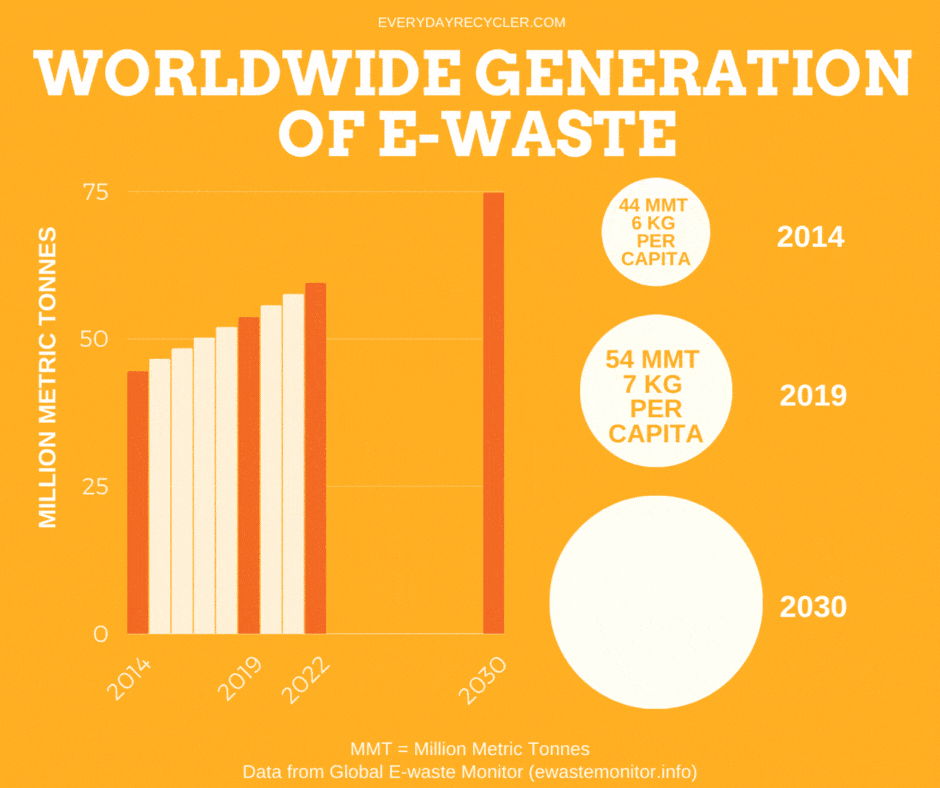
Unfortunately, in 2019 only 17.4% of this e-waste was collected and recycled, wasting US$57 billion of recoverable materials like gold, copper, and platinum.
Why Should You Recycle Your E-Waste
There are some pretty clear reasons why you should be e-cycling or recycling your e-waste:
- Stop toxic substances going into landfills.
- Allow the precious metals and other materials to be recovered and reused in new products.
- Save energy and resources.
- Protect the environment.

In fact, the EPA says that:
- Recycling one million laptops can save the energy equivalent to the electricity used by more than 3,500 US homes in a year.
- And for every million cell phones that we recycle, 35 thousand pounds of copper, 772 pounds of silver, 75 pounds of gold, and 33 pounds of palladium can be recovered.
What Happens To E-Waste When It’s Recycled
Unfortunately, at the moment, there are two different ways that e-cycling occurs. The first is how it should happen, which is under controlled conditions and in a way that protects the people and the environment. The second way is referred to as ‘informal recycling.’
The right way to recycle can be quite expensive, so sometimes companies take steps to save money and send e-cycling to third-world countries like Asia or Africa. Most of these places do not have the proper facilities to handle the waste safely. Their rudimentary methods are dangerous and lead to issues for human health and the environment. This is referred to as ‘informal recycling.’
The Right Way
There are a couple of steps to e-recycling.
- Items are disassembled – Most e-waste is made up of a complex mix of materials, including plastics, metals, and rare minerals. To recycle e-waste, it generally needs to be dismantled. Any components that can be reused are removed then the remaining parts are treated to remove the metals.
- Whatever material is left is then shredded, so the pieces are all less than 10cm. These materials are then sorted into their different components using advanced separation technologies. This might involve mechanical or manual separation, depending on the processing facility. Various methods are used, including magnets, infrared beams or lasers, and water.
Many countries have recognized the need to internally address the e-cycling problem and establish new rules. The Victorian State of Australia, for example, made it illegal to send e-waste to landfills in 2019. The European Parliament passed a similar law in 2019, making it illegal to dump electronic goods in landfill sites.
Informal Recycling
The problem with sending e-cycling to developing countries is the poor working conditions and no controls for environmental protection. The methods for recovering materials are generally unsafe and include burning the devices to melt away the non-valuable materials or using mercury and acids to recover gold.
No protection is given to the workers, no gloves, no masks, they inhale these toxic chemicals all day. These burnt-off toxic substances and acids used for extraction are left to leach into the ground and nearby waterways.
There are groups like the Basel Action Network who are working hard to highlight the illegal trade of hazardous waste. The Basel Action Network is built around the 1989 United Nations Basel Convention. It restricts the trade of hazardous waste between more developed countries and less developed countries.
Unfortunately, the U.S. is not a part of the Basel Convention, but they do have other initiatives they are working on. This includes STEP, a multi-stakeholder initiative that helps members address e-waste issues within their own organizations and provides scientifically-based information.
A study completed by The Basel Action Network in 2016 found that 40% of e-cycling in the U.S. was exported to developing countries, usually Asia, where this informal recycling occurs.

What Items Are Included in E-Waste?
Large appliances
- Microwaves
- Refrigerators
- Washing machines
- Cookers
- Electric fans
- Electric Cookers
- Heaters Fans
- Air conditioners
IT & telecommunications
- Cell Phones
- Smart Phones
- Mobile phones
- Smart Watches
- Computers
- Laptops
- Printers
- Copy Machines
- Fax Machines
- Circuit Boards
- Hard Drives
- Modems
- Network hardware
- UPS Systems
- Audio and Video equipment Bluetooth speakers
Household electronic tools
- Drills
- Saws
- Sewing machines
- Lawnmowers
- Batteries
Small appliances
- Irons
- Toasters
- Kettles
- Coffee machines
- Hairdryers
- Hair Straightener
- Watches
- Cords and cables
- Power Supplies
Home Entertainment
- DVD & Blu Ray Players
- CD Players
- CD’s and DVD’s
- Televisions
- Stereos
- Video Game Systems
- Remote controls
- Cameras
- Video recorders
- Amplifiers
- Musical instruments
- Radios
- Hand-held video games
- Consoles
Other e-waste
- Medical devices
- Automatic dispensers
- Thermostats
- Massage Chairs
- Electric Cords
- Diabetic Testing Equipment
- Heart Monitors
- Defibrillator
- Electric trains and racing cars
There’s bound to be some gadget not on the list; it gets longer every year! Remember, if it has a cord or uses a battery, it is most likely e-waste. And if you are still unsure, check with your local authority or e-waste recycler. I’m sure they will be happy to help.
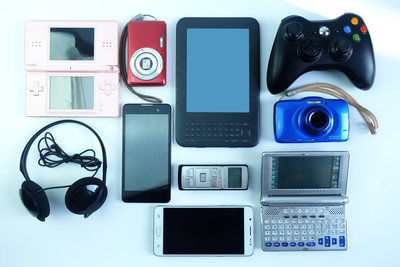
How To Properly Dispose Of Your E-Waste
Now that you have a better idea of the e-waste problem, let’s look at how to recycle your e-waste. For example, let’s say you need to know how to dispose of a microwave or a broken toaster.
The first thing is, the most important thing you should learn is that it does not go in your curbside recycling bin or your trash can.
Here are some steps to help you dispose of your electronic gadgets responsibly.
Do You Really Need a New One?
First, it’s always good to ask yourself if you really need that new T.V. or phone. Not only could you save the energy and resources that went into creating the one you already have, but you can also save yourself a great deal of money. Maybe you can hold off another year and get a little more out of the one you currently have.
Take Care of Your Things
It’s a good idea to take care of your electronics. Keep them clean, take, use protective covers, and be sure to remove batteries from toys and other gadgets if you are not using them for a while. Teach your kids to look after their toys so they will last longer and can be handed down or donated when they have outgrown them.
Fix It
Repair workshops and events have been gaining momentum. You might find that the item can be fixed if it is not working, and you might get some more time out of it. Getting involved in community events like a repair workshop can be fun too.
Maybe there is some new software that will help that will make it perform better.
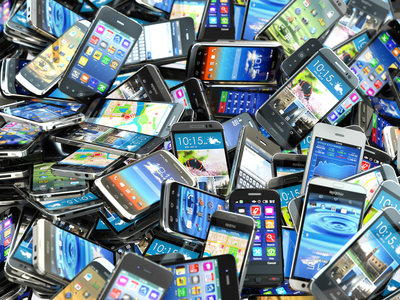
Sell It
Garage sales, eBay, Craigslist, and other common second-hand marketplaces are good places to start if you want to sell your old electronics. Ensure it is in good working condition and the power cord is not damaged before you list it. We recommend that you clearly state the condition and age of the item in the ad for transparency.
Donate It
Check with family members or your neighbors to see if anyone you know could use it. Charity stores do not always accept electronics because of the possible danger if the item is not safe. However, sometimes they will accept items you just need to check. You can also check with your nearby homeless shelters or charities to see if they will take electronic goods.
If you cannot find a charity that will accept it, why not try giving it away for nothing on eBay or using a service like Freecycle.
Before Donating or Recycling your electronics, be sure to delete all personal information.
Take It Back To The Manufacturer
Some companies will take your unwanted e-waste items off you when they are at the end of their life. Some examples are Apple, Best Buy, L.G., Samsung, and Toshiba.
Recycle It
If your electronic item is no longer working, broken, or unsafe, or you have exhausted all of the options above, then it’s time to send it for recycling. Many recycling centers accept e-waste nowadays. Look out for events organized by these groups or even your local council. Remove any batteries from your electronics; they may need to be recycled separately.
Where to Find an E-Cycling Drop Off Point
USA
Some charities are set up for e-cycling expressly. For example, the World Computer Exchange program takes working unwanted computers or computer accessories, refurbishes them, and then donates them to communities in need overseas. Be sure to check their website, where they have a specific list of what they accept.
The EPA has a list of companies on their website that will take e-waste off your hands but here are a few to get you started.
Best Buy, L.G., Samsung, and Toshiba. Dell has a partnership with Goodwill to accept any brand of computer and computer accessories. Check with Goodwill for your nearest location.
In addition to the drop-off points listed above, some tech companies have takeback programs like Apple, which will let you trade-in your old phone and get credit toward your new one. It doesn’t even need to be an Apple phone. Other companies have similar programs like Sprint, Office Depot, and Staples.
Amazon will trade in several devices for a gift card, including kindles, tablets, media players, Bluetooth speakers, and home security devices. They also have programs for cell phones and gaming.
If the device is at the end of its life and you need to recycle it, please don’t put it in the trash can. Try the Recycle Coach Find My municipality to check what services are in your area.
United Kingdom
If your e-waste is still in good working condition, consider selling it or donating it locally. Check with your local charity shops to see what they accept.
Some local authorities accept small electric items in your curbside collection, such as radios, toasters, CD players, electric toothbrushes, or lamps. Check the Recyclenow website and your local council website. You can try Recyclenow’s local recycling locater and check what they accept.
Computers and accessories can be recycled at your Household Waste Recycling Center; however, you might try the WEEEChartity website if you would like to donate gear in good working order.
Charities accept mobile phones or pass them onto someone who can use them through Freecycle or a similar service. Otherwise, if it’s at the end of its life and needs to be recycled, you can drop it off at your Household Waste Recycling Center. Be sure to remove any personal data before you take up any of these options.

Australia
If you are looking to donate, try Salvo Stores, Brotherhood of St Laurence, and St Vincent de Paul Society. They will all accept small electrical items like radios that are in good working condition. You can also try GiveNow to see if there is a location near you. They list charities that will take electrical donations near you.
Some local councils are introducing e-cycling pick-up or at least holding regular drop-off days. There are also similar options as the USA for programs with manufacturers such as Amazon, Apple, Samsung, Dell, LG, and H.P.
The Australian Government has set up an industry-funded program called the National Television and Computer Recycling Scheme for computers and televisions. It means you can recycle your old T.V.s and computer for free. Four companies provide the service, including TechCollect, eCycle Solutions, and Electronic Product Stewardship Australasia (EPSA). Their drop-off points are often convenient locations like an Office works store. Check the website for your nearest location.
Phones can be recycled through Mobile Muster. Australia’s very successful program has been the Cartridges 4 Planet Ark program, where they recycle old ink cartridges. Supported by industry, this program is very well known by most Australians, particularly in the workplace. Some great recycled products are made from cartridges, including a recycled ink product by Lousy Ink.
New Zealand
Any of the charities are Redcross, Brotherhood of St Laurence, and St Vincent de Paul Society, are worth trying if your electronics are still working.
There are several specialist recyclers like TechCollect for e-cycling and Remobile for mobile phones. Some councils organize drop-off days, so check with your local council if you need to know how to dispose of a microwave or other e-waste item.
What is E-Cycling Made Into
The precious metals that are used in many electronic gadgets can be used again and again. Materials that are extracted include plastic, precious metals, glass, and of course, batteries.
Many new items can be made from the materials that are collected from recycling e-cycling. These include new batteries, keyboards, toys, jewelry, new screens for T.V.’s or cabling.
The Wrap
So whether you refer to it as e-cycling, WEEE, or e-waste, it’s time to recycle your leftover electronic gadgets. There are plenty of services available to show you how to dispose of a microwave, T.V., hairdryer, or computer, so there are no excuses. Try thinking about the electrical gadgets you have lying around as a resource that can be made into something new.
We all need to work hard towards increasing the % of e-waste recycled worldwide and decreasing the amount of waste in the world.
Together we can fix recycling!
Sources
- Cleaning Up Electronic Waste (E-Waste)
- Renee Cho, 2018, What Can We Do About the Growing E-waste Problem?
- Electronics donation and recycling, EPA
- What is e-waste? Definition and Why It’s Important, Great Lakes Electronics Corporation
- Basel Action Network (BAN)
- Vanessa Forti, Cornelis Peter Baldé, Ruediger Kuehr, Garam Bel, 2020, The Global E-waste Monitor 2020, United Nations University
- American Chemical Society, 2018, Pulling valuable metals from e-waste makes financial sense










